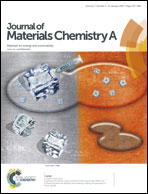Partially nitrided molybdenum trioxide with promoted performance as an anode material for lithium-ion batteries†
Abstract
To obtain new anode materials with improved lithium storage properties, molybdenum oxynitride (phase X) was developed from a partial nitridation strategy by heating bulk molybdenum trioxide (MoO3) in a NH3 atmosphere. The elemental mapping shows homogeneous distribution of nitrogen and the nominal composition of the material was well characterized by X-ray photoelectron spectroscopy (XPS) in combination with elemental analysis. The material was evaluated as an anode material for lithium ion batteries for the first time. A reversible capacity of about 980 mA h g−1 was achieved at a current density of 50 mA g−1, showing significantly improved capability retention compared to bulk MoO3, which was due to its increased conductivity. Considering the ease of large-scale fabrication, molybdenum oxynitride should be very promising for lithium ion battery applications. The strategy may also be applied to other metal oxides to improve their performances in lithium ion batteries.


 Please wait while we load your content...
Please wait while we load your content...